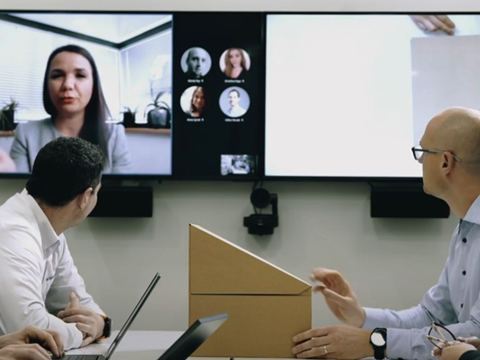
DS Smith has launched PackRight 2.0, a hybrid collaboration service designed to help businesses in e-commerce, fast-moving consumer goods, and more redesign their packaging for improved sustainability – quickly, efficiently, and at low cost.
Hosted at DS Smith’s PackRight Centers in Reading, Pennsylvania and Lebanon, Indiana, the workshops introduce customers to DS Smith designers and engineers and create an opportunity to collaborate on a more efficient, effective, appealing, and sustainability-minded packaging design.
Apparently, the workshops are the first in the United States to make use of advanced visual content platform solutions from Klaxoon, a French start-up in the collaboration tech space.
Aiming to bring together creativity, strategic insights, and technology, DS Smith intends to guide companies through a cheaper, faster, and more efficient design process to produce new packaging in line with its proprietary Circular Design Metrics.
PackRight begins with an initial audit of the customer’s current packaging supply chain, which involves a site visit. DS Smith uses the information gathered to gain insights into the redesigns required to improve value, efficiency, and sustainability metrics.
From here, specialists from the PackRight Center will host an interactive workshop and use digital collaboration tools to generate ideas with client teams. Whiteboard and videoconferencing features are utilized for live questions, voting, word clouds, and other tools to capture and report feedback from participants.
During the Circular Design Metrics analysis, designers from DS Smith will help brands rate and compare the circularity of their packaging designs in the categories
DS Smith’s designers will work alongside customers to conduct Circular Design Metrics analysis, in which they rate and compare the circularity of packaging designs through eight categories; carbon footprint, design for reuse, supply chain optimization, recyclability, planet safety, material utilization, renewable source, and recycled content.
Using digital printing and cutting equipment at the PackRight Centers, workshop leaders can then create prototypes on demand and evaluate their performance using in-house testing equipment. Print samples captured on high-end cameras are used for collaborative review and analysis, while a proprietary DS Smith Value Tool analysis calculates a design’s total cost of ownership to weigh up benefits to the customer.
Overall, the PackRight process is believed to result in ‘effective’ and ‘circular’ packaging designs that improve the effectiveness of the supply cycle, increase sales, and manage risks. DS Smith reports that it recently worked with a South American food brand to set new sustainability targets, and with a leading equipment manufacturer to upgrade its fibre-based packaging solutions.
“Our PackRight Centers integrate circularity with design, improving the process needed to bring inspiration from the drawing board to the factory floor,” explained Steven Rose, managing director for Packaging at DS Smith North America. “No longer just for in-person collaboration, our new PackRight design workshops enable all customers interested in reducing their environmental impact to take advantage of DS Smith’s design and engineering expertise and our proven Circular Design Metrics process.”
CEFLEX and Recyda unveiled a similar solution last year; its ‘Design Check’ tool sought to foster collaboration between designers, technologists, customers, and suppliers of flexible packaging in hopes of unlocking more sustainability-minded packaging designs. design-check.ceflex.eu is described as a free service used to assess packaging portfolios and develop new products.
PreZero also released an online tool thought to help packaging manufacturers and distributors evaluate their product portfolios, save resources, reduce waste, and improve the sustainability of their designs. PreZero SPOT, or Sustainable Packaging Optimization Tool, is browser-based and examines the components of a pack to identify areas of improvement in line with existing legislation.
If you liked this story, you might also enjoy:
How are the top brands progressing on packaging sustainability?
Sustainable Innovation Report 2024: Current trends and future priorities
Reuse vs. single use – which is better for the environment?
The ultimate guide to global plastic sustainability regulation











No comments yet